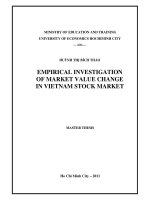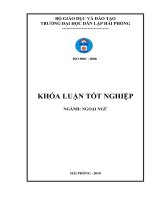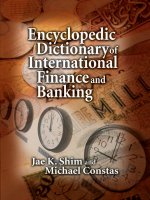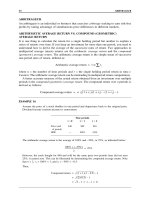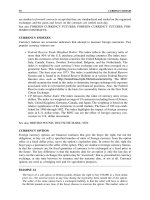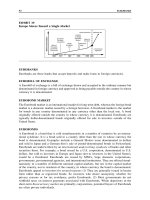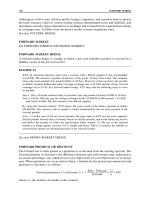Bachelor of finance and banking thesis the test of CAPM in vietnam stock market
Bạn đang xem bản rút gọn của tài liệu. Xem và tải ngay bản đầy đủ của tài liệu tại đây (487.04 KB, 80 trang )
MINISTRY OF EDUCATION AND TRAINING
FPT UNIVERSITY
Bachelor of Finance and Banking Thesis
The Test of CAPM in Vietnam Stock Market
GROUP 8
GROUP MEMBERS
VõThịMỹLinh - FB60224
TiếtKhaiNguyên - FB60019
ĐỗDuyHòa- FB60041
DươngHữuTrí- FB60008
SUPERVISOR
NguyễnThụyNgọcDuyên
EXT SUPERVISOR
GRADUATION THESIS
CODE
Ho Chi Minh City, 8/2014
TABLE OF CONTENTS
LISTS OF TABLE
Table 3.1: The government 2-year bond rate and default risk
Table 4.1: The number of listed stocks in the sample
Table 4.2: Regression results on the CAPM by price return method
Table 4.3: Regression results on the CAPM by total return method
ABBREVIATION
AMEX : American Stock Exchange
APT : Arbitrage Pricing Theory
BE/ME : Book equity value/ Market equity value
BH : portfolio of big size and high book to market equity
BL : portfolio of big size and low book to market equity
BM : portfolio of big size and medium book to market equity
GROUP 8 Page 2
CAPM : Capital Asset Pricing Model
CFA : Chartered Financial Analyst
CRSP : The Center for Research in Security Prices in US
CSMAR : China Stock Market and Accounting Research Database
HML : High minus low
HNX : Ha Noi Stock Exchange
HSX : Ho Chi Minh Stock Exchange
KIBOR : Karachi Interbank Offer Rate
KRX : Karachi Stock Exchange
KSE : Korea Stock Exchange
MAVA : The mean absolute value for the alphas
MSCI : Morgan Standley Capital International
NYSDAQ : The National Association of Securities Dealers Automated Quotation
NYSE : The New York Stock Exchange
SH : portfolio of small size and high book to market equity
SL : portfolio of small size and low book to market equity
SM : portfolio of small size and medium book to market equity
SMB : Small minus big
SML : Security Market Line
UPCOM : Vietnam over the counter market
β : Beta
GROUP 8 Page 3
ABSTRACT
This study provides a traditional valuation technique in estimating the risk and expected return
of assets in the stockmarket. Specifically, this paper discusses the challenges of applying
Capital Asset Pricing Model (CAPM) model techniques in Vietnam stock market, one of the
major Asia frontier markets.
The sample size is picked about 150 stocks from the HSX for testing, and the sample periods
being from March, 2012 to March, 2014. With corresponding monthly yield data, the study
uses quantitative method such as Central Limit Theory and Point Estimator that the CAPM
model is estimated and tested by using time-series test and cross-sectional regression.
On many fronts, our findings show that there is not substantial alignment with CAPM
valuation practices in Vietnam's stock market because the Vietnam stock market is not mature,
GROUP 8 Page 4
the market has been speculative and stock prices were easily controlled.Besides, the following
research may eliminate the limitations of this study in order to get better results.
Keywords: CAPM, Vietnam stock market, valuation.
CHAPTER 1 - INTRODUCTION
1. Background
Vietnam stock market has been appeared and developed more than 10 years, but it still is an
frontier capital market that lack of the significant information of financial organizations and
doesn’t have many tools or models that help in getting the investor wealth maximization and
assessing the level of risk accurately. Following Damodaran(2002), there are three different
approaches to valuation of a publicly traded stock. Firstly, discounted cash flow is the
foundation to analyze and use the other approaches through calculating the present value of
asset based on the future expected cash flow on that asset. Secondly, relative valuation
estimates the value of asset by comparing the pricing of asset to a common variable such as
book value, earnings, cash flows or revenues and it is the approach that is the most valuation
done in the reality. Thirdly, contingent claim valuation that is known as the revolutionary
development in valuation in recent years uses option pricing models to determine the value of
assets.However, these approaches are quite sophisticated and the majority of investors in
GROUP 8 Page 5
Vietnam stock market are individuals who don’t have enough time and specialist knowledge
to use. Therefore, they tend to base on the company’s published information or
recommendations of security organizations when they consider and look for investing in an
industry or a stock. For the above reasons, it is really necessary for Vietnam market to apply a
model that can determine expected return and risk of a stock and provide a helpful and
efficient method for investors.
CAPM was developed by William Sharpe (1964), John Lintner (1965) and Jan Mossin (1966)
independently. It describes the relationship between the systematic risk that the investment
adds to a market portfolio (presented by (β)) and expected rate of return on an asset. Although
CAPM has been doubted about its application in many empirical studies in recently years, it is
still the fundamental model in most real world analysis. Because CAPM can help investors in
classifying stocks, avoiding risk and realizing return through β. Besides, CAPM also provide
investment guidance to investors through estimating risk-return trade-off, investors can
explore if stocks are undervalued or overvalued in order to make decisions. The CAPM model
can be represented as:
Where:
: The expected return of the stock i.
: Risk-free rate (of assets from which the expected returns are certain)
: The expected return on the market portfolio
: The degree of systematic risk of firm i’s stock returns relative to the risk of the
(stock) market portfolio’s returns.
SML is the representation of CAPM. It displays the risk – expected rate of return of an
individual stock under the condition of an efficient market. In SML, the vertical axis is the
risk-free rate, the horizontal axis represents the β and the slope of SML is. This is a helpful
tool to consider whether investors should invest in a stock or not. Every stock is plotted on the
SML individually. If a stock is above SML, it means that this stock is undervalued because
GROUP 8 Page 6
with a given amount of risk (, investors get higher return. Conversely, if a stock is below
SML, it is overvalued because we get lower return with a given amount of risk.
Based on the model of CAPM, for any individual stocks, we can realize that the expected
return will increase when increase, therefore, it is a positive relation between the value of and
the expected return of stock in the market.
2. Theoretical problems
The model always starts with the necessary assumptions that have the effect to simplifying but
still ensure not change the nature of the problem. In general, CAPM also ignores some
complexities of financial market to obtain the linear relationship between risk and expected
return. According to Sharpe-Lintner, there are seven assumptions when applying CAPM:
• Investors are risk-averse, utility-maximizing, rational individuals.
• Markets are frictionless, including no transaction cost and no taxes.
• Investors plan to invest for the same single holding period.
• Investors have homogeneous expectations or beliefs.
• All investments infinitely divisible.
• Investors are price takers.
• The investors can borrow and lend unlimited amount at the risk-free rate
GROUP 8 Page 7
There are some problems arose from conducting CAPM structure model and assumptions as
follows. Firstly, CAPM is based on single-factor model that just use systematic risk () and
eliminate no other investment characteristics in estimating expected return of assets.
Therefore, CAPM may not evaluate the entire risk although it is easy to understand and apply.
Secondly, CAPM is applied in a single - period model that does not consider multi-period
implications because β is calculated based on the historical stock price. Thus, β in the current
period may be negative for the future investment objectives.
Although CAPM makes the restricted assumptions about how markets work and do not
perfectly suitable for the realistic situation, the model requires little inputs. Under these
assumptions, it helps investors in obtaining the risk-return, and generating the efficient asset
pricing model.
3. Practical problems
In addition to the theoretical limitations, implementation of the CAPM raises several practical
concerns, some of which are listed follow. Firstly, Richard Roll (Richard Roll critique 1977)
mentions one reason that CAPM is not estimated accurately about a true market portfolio
because all investable asset and non-investable asset is hardly to be observable. For example,
it is difficult to contain assets in closed economies or nonfinancial. Secondly, proxies for a
market portfolio used by market participants caries among analysts, the country of investors…
that generates different estimated return for the same asset, which is impermissible in CAPM.
Thirdly, estimate for long history of return may be inaccurate representation of the current or
future state of company (time-period bias). Because of the different estimation of β from
different period, CAPM may estimate different risk-return for same asset. For example, a two-
year β is unlikely to be the same as a six-year β. Fourthly, CAPM cannot determine asset
returns by non-systematic risk. So that in empirical study support for CAPM is weak, and it
gives poor predictability of returns. Fifthly, there is obvious to not be similar to CAPM
assumptions that assume investors have the same expectations for a single optimal risky
portfolio. In fact, the different investors have different expectations for the same asset.
4. Research questions
Is Capital asset pricing mode valid in Vietnam stock market?
GROUP 8 Page 8
How does the systematic risk () influence to the investor’s the expected return?
Positive or negative correlation?
Dividend can increase the compatibility of CAPM in Vietnam stock market?
5. Research objectives
The study focus on testing whether CAPM suitably apply for Vietnam stock market
Firstly, systematize the basic theory of CAPM and review some empirical tests.
Secondly, estimate of stocks in HSXthrough two methods: price return and total return.
Thirdly, clarify the affect’s dividend and test relationship between risk and return.
Finally, make conclusion and recommendation.
6. Research scope
With research objectives, the study just focuses on analyzing and processing the sample data
to determine the risk and expected return based on CAPM. After that, recommendations will
be made through the results. This study will not analyze the factors of the market that affect to
the investor decision making. All decision depends on skills and hobby of each investor.
The sample data of this study are gathered through the company in Vietnam stock market
(including only the stocks that are traded on HSX). From the data about capital market of
these companies, we will use normal distribution and then pick the absolute size to decide a
suitable sample size. The time period will be taken from March, 2012 to March, 2014.
7. Methodology and data overview
To verify the application of CAPM in Vietnam, the study gathers data from public firms
registered on HSX through statistical tool and using point estimator to choose study sample
size. The research period is from March, 2012 to March, 2014.
There are three independent variables (risk-free rate, β, and risk premium) and one dependent
variable (expected return of stock). Each independent variable is practiced via different
methods. The result of risk-free rate and risk premium are based on AswathDamodaran
estimation methods.β is estimated through regression linear method that shows the relationship
between systematic risk and return on specified stock.
GROUP 8 Page 9
After gathering and processing database, the study uses descriptive statistic to test whether
CAPM is suitable model when applying in HSX. The study uses some statistical software such
as Excel, Eview.
8. Thesis outline
This study is conducted to test the application of CAPM in Vietnam stock market from the end
of March, 2012 to the end of March, 2014. This study contains 5 main chapters:
Chapter 1 mainly provides the background and the introduction of the objective of the study.
To specific, this chapter will introduce the CAPM, state the CAPM theoretical problems and
practical problems, clarify research question and objectives, and give an overview about
methodology and data.
Chapter 2 discusses the different versions of CAPM including Sharpe and Lintner version,
Black version. Describe three factors model Fama and French.Give the evidences about testing
CAPM in different markets that have the methodology related to this study.
Chapter 3 states the data collection methods and the methodology of this study, and then
processes the data source characteristic.
Chapter 4 provides the result of the study, systematize presentation and analyze the result.
Chapter 5 will provide the conclusion of the compatibility of CAPM in Vietnam stock market
and make recommendations.
GROUP 8 Page 10
CHAPTER 2: LITERATURE REVIEW
1. Introduction
1.1 Overview of reviewed sources
Since the capital asset pricing model was discovered, there have been numerous testing studies
of CAPM. However, the results of these studies are still conflicting. Some authors support for
the CAPM theories when they find the empirical evidence on the relationship between the
expected return and risk of the stock. One of the first studies of this model is "A Theory of
Market Equilibrium under Conditions of Risk" conducted by William F. Sharpe (1964), "The
Valuation of Risk Assets and the Selection of Risky Investments in Stock Portfolios and
Capital Budgets" conducted by John Lintner (1965). Next to Fisher Black (1972) proposed the
Zero β CAPM in the study “Capital Market Equilibrium with Restricted Borrowing”, by using
the basic theory CAPM and replacing risk-free rate with Zero β, these authors found the
relationship between the return and risk of the portfolio. This means that the higher risk get the
higher return.
Conversely, the other authors doubt about the validity of the CAPM on the basis of their
empirical researches. In historical, the rejected studies of the CAPM by author Richard Roll
(1977) in study “A Critique of the Asset Pricing Theory's Tests” and Engene F. Fama and
Kenneth R. French in study “The Cross-Section of Expected Stock Returns” gave empirical
evidence that rejects the validity of the traditional CAPM theory. Besides, there are also many
empirical studies that test the effectiveness of CAPM in different markets including
GROUP 8 Page 11
developing and developed countries in recent years. In general, those studies demonstrated
clearly about the poor performance of CAPM in reality that the result was not consistent with
the actual rate of return. Therefore, the authors tend to improve the CAPM in order to
eliminate its defaults (such as Fama-French model). However, CAPM still one of the most
popular asset pricing models despite the critiques about its application and feasibility because
it will be dropped and not researched until now if it completely defeats.
1.2 Scope and limitation
As this study mentions above, CAPM is developed in the long time by the different authors,
thus, CAPM has a lot of versions that are built on assumptions, circumstances, and the
purposes of those authors. However, it is impossible to review all of the versions, so this study
just focuses on Sharpe-Lintner version and Black version that are known as the most well-
known model of CAPM because of its simplicity, utility and relative faultlessness. Besides,
the study examines the validity of CAPM so the other models that the study mentions just are
used to support.
There are a lot of empirical tests of CAPM in different markets and different period time.
However, the study cannot cover all of the researches that relate to this topic. Therefore, this
study lists a few representative studies as a basic for research. The researches that test CAPM
in the markets as nearly similar to Vietnam, at the same time, have the recently period time
will be selected in order to increase the suitability and application.
The following parts will give an overview about the theoretical review of these two above
versions, next show some critiques of Fama-French about CAPM and introduce their
alternative model – three factors model, then present some approving or disapproving
empirical tests in US, China and Pakistan stock market.
2. Model discussions
2.1 The single factor model: Sharpe and Lintner version
Markowitz (1959) and Tobin (1958) informed the one period mean-variance portfolio model
which was built on the expected utility mode of Von Nuemann and Morfenstern (1953) and is
extended into the Sharpe (1964) and Lintner (1965) in turn. Markowitz mean-variance
portfolio is the portfolio that minimizes the variance of portfolio return in a given expected
GROUP 8 Page 12
return and maximizes the expected return in a given variance (Fama and French, 2004). This
analysis stated that investor should allocate their wealth among the variety of assets available
in the market, given that investors want to maximize utility in one-period. According the
investor wealth allocation decision characteristics, the Sharpe-Lintner asset pricing model
built the relationship between the expected return and risk for assets and portfolios.
In fact, the Sharpe-Lintner model is also similar to other versions of CAPM that has to comply
with some assumptions about the real world in order to make the model more rational. These
assumptions include (a) all investors are risk-averse investors who maximize the expected
return at the end of period wealth, (b) the investors are price takers and have homogeneous
expectations about asset returns that joint normal distribution, (c) the investors can borrow and
lend unlimited amount at the risk-free rate, (d) the quantities of assets are fixed and all assets
are marketable and perfectly divisible, (e) asset markets are frictionless and information is
costless and available to all investors, and (f) there are no market imperfections such as taxes,
regulations, or restrictions on trading (Attiya Y. Javed, Alternative Capital Asset Pricing
Models: A Review of Theory and Evidence).
When investors can borrow and lend unlimited amount at the risk-free rate, the expected
return of asset that is uncorrelated with expected return of market (), at least must be equal to
the risk-free rate. Therefore, under the above assumptions, CAPM’s goal is to minimize the
variance and maximize the expected return of their portfolios (Athayade and Flores, 1999)
with the amount of risk-free rate. Sharpe-Lintner version of CAPM can be equated as:
is presented as expected return on stock i, is risk-free rate, is expected return on market
portfolio and is the measure of systematic risk of stock i to market and can be calculated
through formula Therefore, combining the equation with the assumption of risk-averse
investors, it seems to be rational to conclude that high risk (high β) stock should be received
the higher expected return than low risk (low β) stock. To circumstance, systematic risk equal
zero (β= 0), investors will expected to get the amount of return that is equal to risk-free rate at
least. When systematic risk of stock is higher than zero, the expected return of investors will
GROUP 8 Page 13
be higher than risk-free rate by multiplying risk premium and the proportion of systematic risk
(β). Through that, we can draw some important following:
• If β equal to 0 – the expected return of stock have a β equal to 0, is riskless profit,,
because in this case:
• If β equal to 1 - the expected return of stock have a β equal to 1, will be market return,,
because in this case:
• In Sharpe-Lintner model, these authors still didn’t mention about negative’s situation.
For this reason,a frequently asked question is whether or not β is negative. In fact, the
answer is yes when some stocks move in the opposite direction of the stock market and
make the overall risk of the portfolio decrease. Although these stocks are rare, they do
exist. For example, the companies that do most of their business overseas may get the
negative β because it is not affected by the domestic market. In consequence, negative
β cause that the expected return is lower than risk-free rate. However, it is reasonable
because it reduces the risk.
The expected return of a stock can positively related to the risk of stock, meaning that
investors expect the stock high risk will have high profit and vice versa. In other words,
investors will hold risky stocks if only the expected profit is large enough to offset the risk.
Sharpe and Lintner were found a new field in asset pricing model. They detected the linear
relationship between the expected return of asset and the risk of asset.
Otherwise, from the equation of CAPM, the risk premium can be written:
Or
GROUP 8 Page 14
Where: is the excess expected return on stock over the risk-free rate and is the excess
expected return on market portfolio over the risk-free rate. This equation says that the
expected asset risk premium is equal to the multiplication of its β and the expected market risk
premium. Besides, it also satisfies the assumptions of Gauss Markov regression that the
expected value of the error term is zero for all observations and is deterministic and
uncorrelated with the error (. Thus, when testing and using regression, CAPM is usually
written as: (Attiya Y.Javed, Alternative Capital Asset Pricing Models: A Review of Theory
and Evidence)
In the equation, is the rate of return on stock i at time t, is the rate of return on the market
portfolio at time t and is error term. This regression can help us to estimate through the stock
price return and market return. Coefficient is defined as the coefficient of variation measure
individual stock returns with volatility profitable market portfolios. For example, stock A have
β is 2 indicates that stock A returns double fluctuate profitable market, meaning that when
the economy is good, a rising profit of stock A faster than the market, but when the economy
is bad, the stock A returns more rapid decrease than the market. β is defined as the coefficient
of variation measure of profitability. Therefore, β coefficient is considered as measure of stock
risk. Because authors started coefficient β is used to measure the risk of a stock. Therefore, the
expected return of a stock can positively related to its β coefficient.
2.2 The two factors model: Fisher Black version
Realized that borrowing and lending unlimited amount at the risk-free rate is unrealistic
assumption, Fischer Black (1972) eliminated this assumption and suggested using zero- β
portfolio as the substitute of risk-free rate in Sharpe-Lintner version. In this version, each
investor can hold a different portfolio of risky asset, and market portfolio will be a weighted
sum of the investors’ portfolios. Following Black, he stated that if a portfolio has the risk-free
rate (such as Sharpe-Lintner version), it will be less risky than the portfolio that has zero-β
portfolio. Because Black model treats all assets as risk but it classifies the risky asset
portfolios that has minimum variance of all portfolios and is uncorrelated with market
portfolio () is called as a zero-β portfolio. Reasonably, the expected return on portfolio must
be greater than the return on portfolios that has risk-less asset availably. Therefore, Black
GROUP 8 Page 15
thinks that expected return on zero- β will reflect more accurate about the return-risk
relationship of assets than using risk-free rate.
Theoretically, Black version of CAPM depends on two factors: zero β and non-zero β
portfolios, thus, it is also known as two-factor CAPM and it has some different results in
estimation of the expected return of stocks. Black (1972) required two assumptions that are
more restrictive than the usual assumptions used in CAPM. First, it is assumed that market
have two cases. There is no riskless asset and no risk-free rate borrowing or lending.
Otherwise, if there has a riskless asset, investors can perform long positions in the riskless
asset, however, the short positions (borrowing) in the riskless asset are not allowed. Second, in
both cases, investors have been assumed that they can take unlimited long or short positions in
the risky assets.
Black’s equation may be presented as following:
Where:
: The expected return of asset i
: The expected return of a zero- β portfolio z
: The expected return of the market portfolio
The above equation can apply for any asset and portfolio that obeys the assumptions of Black
version. If β is equal to 0 it is obviously that the expected return of stocks will have the same
expected return of portfolio z () because the return of portfolio z is independent from the
return of market portfolio. If there has the existing risk-free rate that is uncorrelated with
market portfolio; it seems to be a zero-β portfolio and we can use it for calculating.
Nevertheless, almost circumstances of zero- portfolio require the calculation and estimation
based on time-series data of stocks if stable over time, unfortunately, zero- is not immediately
observable (Diderik Lund, 2004) because there is difficult to distinct from the riskless asset
that is completely uncorrelated with market portfolio, the data that is set in the model may
GROUP 8 Page 16
have some variances. Thus, some researches assumed that zero-β portfolio is constant
(Shanken, 1985).
Although Black found that the evidence indicates the existence of a linear relation between
return and risk when is consistent with a form of the two factor model which specifies the
realized returns on each asset to be linear function of the returns obtained on the two factors,
the Zero- portfolio can be considered a weak factor given its low signal to noise ratio (low
explanatory power of the cross-section of stock return by itself and difficulty in obtaining the
expected return of zero- portfolios), not taking it into account in the time - series regression
leads to a worse fit of the data by the model (the data is used in estimating usually is in the
past), generating more intercept significantly different than zero that produce more abnormal
returns (Seung C. Ahn& Alex R. Horenstein). A positive value of intercept can lead to the
rejection of the CAPM theory and the CAPM considers that the intercept is zero for every
asset (Kapil&SakshiChoudhary).
The result of Black indicated that the expected return on any risky asset is a linear function of
its just as it is the risk-free rate borrowing and lending in Sharpe-Lintner version. It means
that expected return of a stock is related to the risk of stock, if investors expect to get a high
return, they must bear high risk and if investors want to get rid of risk, they will just receive a
low return. However, if there is a riskless asset in Black version, the slope of the line relating
the expected return to its must be smaller than no restrictions on borrowing. Thus, both
models of Sharpe-Lintner and Black concluded the linear relationship between the expected
return and risk despite some differences in the estimation results.
Alternatively, Black, Jensen, and Scholes (1972) also did a research about “two-factor model”
that analyzes the returns on portfolios of stock at different level of. They found that this model
does not provide a consistent result with the Sharpe-Lintner model. It estimates the expected
returns on portfolios of stocks are higher at low levels of and are lower at high levels of than
Sharpe-Lintner version. Therefore, the empirical findings of Black, Jensen, and Scholes are
consistent with the Black model in which borrowing is restricted.
GROUP 8 Page 17
2.3 The three factors model: Fama-French
According the assumptions that CAPM requires to calculate the expected return of assets in
the real world, many researchers concluded that CAPM still has not given accurate results.
There are two problems that were mentioned by Fama and French (2004). Firstly, it is
behaviorists. Their view is based on evidence that stocks with high ratios of book-to-market
(BE/ME) are typically firms that have fallen on bad times, while low ratios of BE/ME is
usually growth firms. With the information of sorting firms on BE/ME ratios, investors tend to
overreact to good and bad times. The result is the change of stock price that is too high for
growth firm (low BE/ME) and too low for distressed firms (so-called value firms) (high
BE/ME). In fact, some investors tend to feel extremely excited about stocks that have done
very well in the past or had the good news. They buy them and make other follow, so that
these stocks become overpriced. Similarly, to stocks that have the poor performance in the
past, they will not be attractive so it is underpriced. Therefore, when the overreaction happens,
there is high return for value firms and low return for growth firms (Josef Lakonishok, Andrei
Shleifer and Vishny). Secondly, the investors need a more complicated asset pricing model
because CAPM is based on too many unrealistic assumptions. For instance, CAPM assume
that investor want to maximize the expected return at the end of period and do not care about
labor income or future investment opportunities, so a portfolio’s return variance does not
reflect all of aspects of risk therefore, β is not the description completely of an risky asset and
this cause the difference in expected return among investors by the differences in β.
To response to the poor performance of the CAPM, Fama and French (1993) proposed a three
factors asset pricing model (it also called as Fama-French model) for calculating the expected
return. This model are based on three factors namely: excess market portfolio return, the
difference between return on portfolio of small stocks (relative to market capitalization) and
the return on the portfolio of big stocks, and the difference between the return on a portfolio of
high BE/ME (book-to-market equity) stocks and the return on a portfolio of low BE/ME
stocks. The formula is written as:
Where:
GROUP 8 Page 18
: The expected return of portfolio
: Risk-free rate of return
: The expected return of market portfolio
SMB : (small minus big) the expected value of the difference between the returns on
diversified portfolios of small and big stocks.
HML : (high minus low) the expected value of the difference between the returns on
diversified portfolios of high and low BE/ME ratio on stocks.
: are the corresponding coefficients
This model provides a competitive advantage comparing to CAPM because CAPM is just a
single factor model. Fama and French (1993) find that the three factors model captures much
of variance in average return for portfolios based on size, BE/ME that cause problems for
CAPM. Therefore, the investors typically concede that the three factors model can determine
variation in returns missed by the market return and the size and value effects in average
returns that is unexplained by the CAPM. However, from a theoretical perspective, the main
shortcoming of three factors model is its empirical motivation that investors are usually not
motivated to predict the SMB (small minus big) and HML (high minus low) in calculate the
expected return (Fama and French). Besides, this model is not cost effective that does also not
perform significantly better than CAPM when it applies to individuals stocks (J. Barthody and
Peare).
3. Empirical Studies
In this part, author will show some empirical studies and evidences of testing CAPM and three
factors model Fama-French in different markets and samples to support ideas and objectives
for this paper. The empirical part, author divides into three main purports. Firstly, the testing
CAPM and three factor model in different samples will be said in 3.1, 3.2, and 3.3. In part 3.1,
the study examines which model can give better result in estimating stock portfolio return, and
the result of study stated that the three factors model can explain better return rate of stock
portfolio than the CAPM. In addition, the study also said that the other factors can influence to
the expected return of CAPM equation. In contrast, the study 3.3 give contrast result when
GROUP 8 Page 19
examined whether the effectiveness model by using two separate portfolio groupings, the first
grouping is 25 size and book to market equity portfolios and the second grouping is portfolio
of 12 industries. The first group portfolio result is the three factor model maintained its
dominance over the CAPM but the result of testing second group portfolio is more interesting,
the CAPM now demonstrated superiority the three factor model. For other sample test such as
study 3.2, J. Bartholdy and Peare provide the result the CAPM work much better than the
three factor model for estimating the expected return of individual stock. Secondly, the study
examines the validity of CAPM in emerging and developed markets. Inspecifically, the study
3.3 tests CAPM and three factor model in U.S developed markets, and the result stated that
both CAPM and three factor model cannot rejected. On the other hand, the study 3.4 tests the
validity of CAPM in China stock market, and the result of study is insignificant and β value
cannot apply to present the expected return accuracy. To contrary, the study 3.5 is also the
rejection of CAPM in Pakistan stock market when using hypothesis for determining the
explanatory power of CAPM in estimating return of oil, gas and fertilizer companies listed on
KSE.Thirdly, the last study 3.6 talks about the effect of dividend yield to stock return through
the study “Dividend yields and Stock returns: Insight from the Empirical Evidence of Korea
conducted byJinwoo Park in 2010.
3.1 An Empirical Analysis of CAPM and Fama-French in
China Stock Market
Some empirical studies have pointed out that CAPM cannot estimated the return of stock
portfolio accurately, and employed the other models can give better result such as three factors
models for example. That also reported that the CAPM had poor performance in estimated
asset return.
In 2009, Professor Liu Yaoguang published his study was entitled "An Empirical Analysis of
Cross-Section Stock Returns on the Chinese A-Share Stock Market." The research objectives
is to check the effectiveness of the three factors model Fama-French (1993) reported in
estimated expected return of the A-share of China's stock market, in the period from 1996
-2005. At the same time, the authors conducted a review of this model is more effective in
predicting return the stock compared to the traditional CAPM.
GROUP 8 Page 20
The data used in the research include return rate of the companies listed on the A-shares China
market, during the period January 1996 to December 2005. Samples of companies in the
research including companies have normal equity capital and a positive book value of equity.
However, the return rate of the companies has negative book value of equity still used to
calculate the market return. Data of book value and market equity was collected from CSMAR
databases.
In Liu’s study was tested three factor model of Fama-French and the CAPM for both the
Shanghai and Shenzen stock market. The research's methodology based on the methodology in
studies of Drew (2003); studies have inherited methods in the study of Fama and French
(1993) applied to the stock market with small size. The list is set up every year, the entire
sample is divided into two types of categories on the scale. By using the midpoint of market
value for the whole sample, with a market value collected at the end of December each year,
the sample was divided into categories of small companies, including the company's market
value of equity is less than the midpoint, and the list category of large companies, including
companies with a market value of equity is greater than the midpoint value. Then the sample
was divided into three categories have equal number of companies based on the BE/ME ratio
of each company in the sample. Accordingly, we will have been collected into six categories:
SL, SM, SH, BL, BM, BH. All six of this list will be re-established at the end of December
each year, when the value of scale and proportion of BE/ME are changed at the end of the
year. Regression testing is conducted in accordance with the idea of adding turn, size factors-
SMB and factors BE/ME ratio- HML into market factor of CAPM model, consider the impact
of these factors by observers see the explanatory power of the model after adding other
factors.
Adjusted for six securities portfolios are averagely increased by 3% when the size factor-
SMB was added to the CAPM. All regression coefficients of market factors remain positive
and statistically significant. Portfolio of small capital securities have regression coefficient on
the scale is a positive value, and negative regression coefficient for portfolio of big capital
securities. That means that the scale factor negatively affecting the stock market in China.
Compared with the regression results for the CAPM, after adding size factor on the market
factor model, although adjusted values was not increase too much, but it also provides
GROUP 8 Page 21
evidence that the model CAPM was increase the explanatory power of estimated cost of equity
by the size factor. On average, the regression coefficient of the securities portfolio with high
BE/ME ratio have higher value than securities portfolio with low ratio BE/ME. Adjusted
average increased by 3% while the BE/ME ratio factor was added to the market model CAPM.
To consider models in two model CAPM and three factors model Fama-French which will be
operated more efficiently, Professor Liu comparing adjusted values and the intercept term of
each model. The results show that the of the three factors model have higher value than the
CAPM average by 6.6%. Three-factor model can explain better expected return than the
CAPM. When running the regression for CAPM, the intercepts coefficients portfolios are
significant at the 1% significance level. This is showed that there are other factors that
influence the expected return, such as the size factor and the BE/ME ratio. In contrast, the
intercepts coefficients when run three factors model are not statistically significant at the 1%
significance level. Thus it can be stated that the three factors model can explain better return
rate of stock portfolio than the CAPM.
3.2 Estimation of Expected Return for Individual Stock:
CAPM vs Fama-French
The most practitioners tend to use a single factor model (CAPM) to estimate the expected
return for an individual stock and three factors model (Fama-French) for portfolio returns
academic. J. Bartholdy and Peare (2002) conducted the research about “The estimation of
expected return: CAPM vs Fama-French” in order to compare the performance of the Fama-
French model with the CAPM for individual stocks. The data of this study was collected the
daily adjusted prices from CRSP (The Center for Research in Security Prices in US) with the
time period from 1970 to 1996. Particularly, the daily return was calculated by the simple
holding period rate of return between days. Weekly return was taken from Wednesday to the
next Wednesday to eliminate the effects from weekends and Mondays because there has the
volatility of stock returns over weekends (Peter Fortune). And end of month stock prices were
used as monthly returns. Besides, the 3-month T-bills was used for the risk-free rate for the
time-series regression. The methodology of the study follows the two main steps. Firstly, they
calculated the expected return of individual stock based on CAPM that are obtained by using
different time frames, data frequencies and indexes. The research found that five years of
GROUP 8 Page 22
monthly data and an equal-weighted index (every stock is given the same weight or important
in a portfolio or index) provide the best calculation. However, the performance of this model
was still poor that it causes for the average three percent of differences in returns. Secondly,
they used Fama-French model to estimate for individual stock return by using five years of
monthly data. Unfortunately, this model did not work much better than CAPM because it
explained on average five percent of differences in return. Therefore, the results provide a
rational explanation for why CAPM is used so extensively by practitioners that calculate the
expected return of individual stocks.
3.3 Empirical Evidence from America Stock Market
With the purpose is to compare and test the effectiveness of two asset pricing models that are
the Sharpe &Lintner CAPM (single factor model and Fama-French (three factors model),
NimaBillou conducted a research named “Tests of the CAPM and Fama and French Three-
Factor Model” in 2004 through testing in two separate portfolio groups. The first group
contained 25 portfolios that was constructed and represented by the intersections of 5
portfolios formed on size and 5 portfolios formed on the ratio of BE/ME. The study will test
this group in two different time period, including from 7/1963 to 12/2003 for a total of 486
observations and from 7/1926 to 12/2003 for a total of 930 observations. The second group
was 12 industry portfolios that have the available data, but this group was examined in three
periods: 7/1926 to 12/2003 for a total of 930 observations, 7/1963 to 12/1993 for a total of 366
observations, and from 7/1963 to 12/2003 for a total of 486 observations. The portfolios
include all NYSE, AMEX, and NYSDAQ stocks and the risk-free rate was taken by the one
month Treasury yield that is provided by Ibbotson and Associates. Besides, the independent
and dependent variables for both the CAPM single factor model and Fama-French three
factors model were sourced from Kenneth French’s website.
The methodology for evaluating two asset pricing models of this study was to use the MAVA
(The mean absolute value for the alphas) by looking at the t-statistics for the alphas in order to
observe the statistical significance. This method indicates that the model with the lowest
MAVA for the alphas, or intercepts, is a better model theoretically in estimating the portfolios
returns because the CAPM implies that the value of alphas or intercept should be zero.
Looking at the finding results of this study, at the first portfolio group, it becomes clear that
GROUP 8 Page 23
the Fama-French model demonstrates its superiority. To specific, from 7/1963 to 12/2003, the
CAPM displayed the MAVA of 0.3 versus the MAVA of 0.13 for the Fama-French. In
addition, the Fama-French model had a higher value of than CAPM where 0.89 versus 0.72.
From 7/1926 to 12/2003, it was the same that the MAVA of CAPM is 0.23 and higher than the
MAVA of 0.19 for Fama-French, but is lower where 0.77 versus 0.88. At the second portfolio
group, it was inversely. From 7/1926 to 12/2003, the CAPM showed the MAVA of 0.11
versus 0.14 for Fama-French with is 0.75 for CAPM and 0.77 for Fama-French. From 7/1963
to 12/1993, the MAVA of CAPM and Fama-French were 0.1 and 0.14 with is 0.73 and 0.77,
respectively. From 7/1963 to 12/2003, it was similar, CAPM had a lower MAVA and than
Fama-French with 0.11 versus 0.13 and 0.66 versus 0.7.
With the above results, for 25 portfolios, Fama-French model is better than CAPM but for 12
industry portfolios, CAPM is judged the more effective model. Thus, this evidence indicates
that the author should not be based on only one type of portfolio group in order to evaluate
whether or not an asset pricing model is superior to others. All in all, the study concluded that
CAPM single factor model and Fama-French three factors model had the effectiveness in US
Stock Market.
3.4 The Application of CAPM in China Stock Market
Many researchers conducted a number of empirical cases which concluded both positive and
negative results in order to test the effectiveness of CAPM since it was announced and
developed. Therefore, with the uncertain results of previous studies, Fan Wang (2013) did a
research “A test of CAPM in China’s Stock Market” to answer the question whether or not
CAPM is the correct model for the emerging stock market as China. To specific, the objective
of the study is to examine the relationship between the expected return and risk of stocks.
Being along with this purpose, the study focus on the test of CAPM on China stock market
which mainly contains the stocks traded in Shanghai Stock Exchange and Shenzhen Stock
Exchange by using the supportive statistical software such as SPSS, Stata, and Eview for
calculating and analyzing data. Besides, the sample data of the study was collected through
these above two stock exchanges that randomly selected 90 stocks. The time period is set from
Jan 4
th
, 2012 to Dec 31
st
, 2010, thus, the data set just contains 1 year data of the listed stocks.
GROUP 8 Page 24
To execute the examination of the study, Fan Wang will clarify and obtain the factors of
CAPM such as risk-free rate (this study used bank loan rate of Shanghai banks as a risk-free
rate), risk premium (although there are a number of indexes in Shanghai stock exchange, the
study just use Shanghai & Shenzhen 300 index as the return of market because this index
reflects the market trend for both of the stock exchanges), and apply a two-step regression to
actualize the whole examination. In the first step of regression, the study calculated the β of 90
stocks of the sample through conducting a regression between the return of the stocks and the
return of the market index by using a time series analysis. In the second step used a cross-
section regression which targeted every stock in the sample through conducting a regression
between the β that was obtained in the first step and the geometric mean rate of return in order
to obtain the SML. The purpose of this step is to compare the result with the estimated result
of CAPM. Furthermore, SML also help them in indicating what stock is underpriced and what
stock is overpriced.
With the empirical test conducted, Fan Wang concluded that CAPM still is not the right model
for China stock market for some following reasons. Firstly, the parameters of the estimation
model is insignificant, the correlation and the covariance between the expected return of the
stocks and the predicted systematic risk are relatively weak. Similarly, the explaining ability
of systematic risk to the rate of return is relatively low (Adjusted is just 29%). Therefore, the
linear relationship between rate of return and the systematic risk is not consistent. For
example, a high risk of stock does not always get a high return and conversely. Secondly, the
China stock market is still an emerging market which the market is inefficient and immature
so it does not obey all theories and assumptions of CAPM. Thus, when the study obtained the
data in China stock market, the result is insignificant and value cannot apply to present the
expected return accuracy.
3.5 Empirical evidence from Karachi Stock Market
H. JamaZubairi, ShaziaFaroog announced “Testing the validity of CAPM and APT in the oil,
gas and fertilizer companies listed on the Karachi stock exchange” in Pakistan business review
October 2011. The research aimed to investigate whether CAPM is a valid model for
evaluating the relationship between risk-return of fertilizer and oil& gas sector companies
listed on Karachi Stock Market. The consequence of investigating showed that CAPM is
GROUP 8 Page 25
